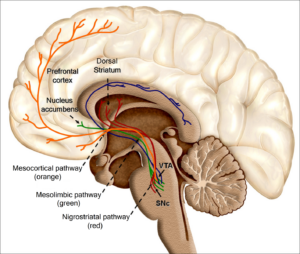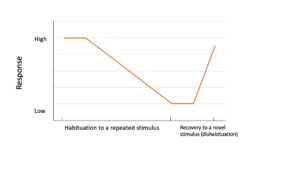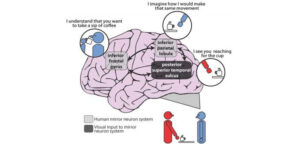
The internet is the invisible third parent of recent generations, teaching and influencing the minds of all curious enough to venture into its vast depths. Its development and prominence resulted in easy access to a multitude of different sources right at one’s fingertips including news, entertainment, and, of course, pornography and other sexualized media. Due to the unregulated nature of the internet, pornography was able to gain widespread traction in recent years. Presently, people can easily access visual sexual stimuli with one quick Google search rather than having to physically attend adult bookstores or movies. The ease of access, affordability, and anonymity that comes with the internet all constitute factors which contributed to the rise in pornography usage in the United States. Recent data has shown that 61% of US men and 41% of US women consume pornographic material regularly each month (Kühn et al., 2014). In addition, an estimated 50% of the total traffic on the internet has been associated with material pertaining to sex, which highlights the immense usage of pornographic material at a global level (Kühn et al., 2014) Although consumption of pornographic material in and of itself is not necessarily a bad thing, it can quickly lead to consequences if exposure occurs frequently and at high levels.
Contrary to popular belief, addiction is not merely limited to substances such as alcohol and drugs (Jha and Banerjee, 2022). Addictions are predominantly mediated by the reward center in the brain, alongside the memory and motivation centers; virtually any behaviors and mechanisms can result in an addiction so long as these pathways in the brain are reinforced. Common sources of addiction include those involving the use of psychoactive substances such as heroin and opioids in addition to those involving behavioral patterns like excessive internet and social media usage, gambling, and pornography (Love et al., 2015). Addiction to pornography yields a multitude of harmful consequences, both to the person addicted and to those around them. Such consequences include altered neurochemical pathways in the brain, uncontrollable and compulsive habits despite harm to one’s emotional, physical, or financial wellness, decrease in sexual gratification, and the actualization of violent and borderline abusive sexual behaviors.
As with any other addiction, there are several biological explanations as to why people consume pornographic material. One explanation is the drive reduction theory of motivation. Developed by Clark L. Hull, the drive reduction theory asserts that motivation arises from the tendency of humans to want to satisfy internal and biological drives to return the body to homeostasis, or its equilibrium state. An example of the drive reduction theory in action lies in the all-familiar experience of hunger. When one becomes hungry, chemical signals are sent from the visceral digestive organs to the brain, which results in a drive for the reduction of this hunger through the consumption of food.
The sexual behaviors of humans operate in a similar fashion. The hypothalamus is one of the main parts of the brain and is responsible for regulating homeostatic behaviors including the “four F’s”: feeding, fighting, flighting, and fornicating. The hypothalamus has several significant and complex functions in the brain and body, one of which being that it promotes sexual arousal and activity when undergoing stimulation by catecholamines, neurotransmitters derived from the endogenous amino acid tyrosine (Iovino et al., 2019). In the context of the drive reduction theory, the stimulation of the hypothalamus, along with other structures in the brain, leads to sexual arousal and the internal motivation to satisfy this arousal through the acts of sex or masturbation. People, especially those with limited sexual options, use pornography as a means to satisfy sexual drives. The significance of role of the hypothalamus in sexual arousal and function has been further confirmed through various studies. In one such study conducted by Miller and colleagues, a 50-year-old male patient had sustained damage to his hypothalamus resulting from an invasive glioma, a type of brain tumor (Miller et al., 1986). Correspondingly, the patient experienced sexual dysfunction in the form of erectile and ejaculatory difficulties, in addition to altered sexual preference and pedophilic tendencies.

Pornography addictions, like all other addictions, are mediated through the dopaminergic pathway in the brain, another significant brain structure. The dopaminergic pathway, also known as the mesolimbic system, is one of four neuromodulatory systems in the brain and is responsible for several physiological and behavioral processes including motor control, motivation, and reward. Neuromodulatory systems are composed of “small pools of neurons” located throughout different regions of the brain (Lewis et al., 2021). The dopaminergic system functions in reward and motivation by releasing bouts of dopamine to targeted areas of the brain whenever a rewarding stimulus is experienced, allowing one to experience feelings of pleasure. This results in positive reinforcement, making one more likely to expose themselves to the stimulus in order to receive the same pleasurable experience once again (Love et al., 2015). Dopamine surges in the brain play a significant role in reinforcing behaviors that are necessary for survival, such as eating and drinking water. However, these surges can result in an addiction when an individual develops tolerance to the rewarding stimulus. When this happens, normal brain function is disturbed, and neuronal changes are observed.
One of the ways in which pornography can alter brain function is through a process known as habituation. With habituation, frequent exposure to a particular stimulus results in a diminished response to that stimulus over time. In other words, constant consumption of pornography results in a diminishing of a pleasurable response. As a result, people find themselves requiring increased levels of the stimulus in order to achieve the same level of pleasure from the dopamine being released. This behavior generates an addiction to pornography because it results in individuals advancing to “more hours per week of use” or “more explicit and graphic pornography” to maintain the same levels of reward in the brain (Jha and Banerjee, 2022). One study observing the behaviors of compulsive users of pornography found that the users experienced higher levels of desire in response to sexually explicit videos as opposed to erotic clips when compared to a control group (Jha and Banerjee, 2022). This demonstrates the effects of tolerance on the brain and how repeated exposure to a rewarding stimulus eventually results in the need for greater stimulation or more intense exposure in order to achieve an adequate response.

This phenomenon results in negative consequences on the grand scale. One study aimed to analyze the relationship between problematic pornography use and sexual and gender violence. In this study, a majority of both males and females recalled having been exposed to pornographic material prior to the age of fourteen, however males were generally exposed at younger ages and engaged with the material more frequently. Both factors have been linked to the generation of problematic pornography usage and the internalization of harmful attitudes pertaining to sexual coercion and aggression (Bernstein et al., 2022). Another study conducted an analysis on the types of content displayed in the best-selling pornographic videos. The findings were concerning: ninety-four percent of scenes portrayed women as the targets of sexual aggression while ninety-six percent of scenes portrayed women to be experiencing pleasure in response to the aggression being enacted onto them (Brem et al., 2018). The study concludes that such content in addition to the frequency with which men consume pornographic material are positively correlated with the emergence of both physical and sexual violence against women.
This data indicates that there is a relationship between the consumption of pornography hosting themes of sexual violence and abuse and the occurrence of these crimes in real life. A phenomenon known as “transfer learning” is one possible explanation for this. Transfer learning is the process in which an individual does to themselves or their partner actions that they have seen portrayed in pornographic videos (Vera Cruz and Sheridan, 2022). This is analogous to the psychological phenomenon of “mirroring”, where individuals imitate and encode facial expressions, vocal cues, and behaviors as a form of learning. Mirror neurons play a significant role in the behavioral patterns of an individual and the ways in which they interpret the behaviors of others (Kilner and Lemon, 2013). This idea of transfer learning, coupled with the fact that much of the material found on adult sites constitutes themes of sexual violence, indicates that some consumers of pornographic material may be inflicting violent and harmful acts on their sexual partners. In fact, one study analyzing the normalization of sexual violence due to pornographic influence among young Mozambicans found that approximately sixty-two percent of males and three percent of females self-reported to watching pornographic content frequently, averaging once a week (Vera Cruz and Sheridan, 2022). Furthermore, seventy-eight percent of males and nine percent of females had “occasionally engaged in sexually violent acts that included infliction of physical violence, real or simulated, on their sexual partners” (Vera Cruz and Sheridan, 2022). These results are highly concerning and emphasize the consequences of the regular consumption of pornographic material on the individual and their sexual partners. Frequent consumption of such content results in behavioral patterns mimicking those consistently promoted in the videos, which are often violent and harmful.

Such behaviors are only one example of the dire impacts arising from addiction to pornography. Another consequence includes disruptions to an individual’s circadian rhythm and emotional regulation. A study conducted by Musetti and colleagues focused on the relationship between problematic online pornography use (POPU) and insomnia symptoms during the COVID-19 pandemic, in addition to the psychological mechanisms underlying this relationship (Musetti et al., 2022). The COVID-19 pandemic marked an incredibly difficult and isolating period of time for many across the globe. Due to the psychological stress of the pandemic, many people found themselves turning to “internet and digital technologies” as a coping mechanism. Involvement and participation in such activities does not necessarily correlate to negative outcomes, however some people experienced a reduction in social interactions and impairment in their ability to carry out day-to-day activities as a result. The study found that engagement in POPU has been linked to the suppression of melatonin secretion in the brain as a result of the chronic exposure to blue light that is associated with persistent screen-exposure (Musetti et al., 2022). Correspondingly, individuals have found themselves to be experiencing disturbances in their sleep-wake cycles, with some struggling with insomnia or difficulty in initiating or maintaining sleep. Furthermore, POPU has been linked to “higher relational problems and lower mental health” which can be attributed to the fact that POPU and excessive use of pornography have been linked to “increased stress and anxiety, social impairment and isolation, sexual dysfunctions, and sleep disturbances”, all of which are factors that influence the wellbeing of individuals and their interpersonal relationships (Musetti et al., 2022).
Though addictions can be difficult to break, it is not impossible. One method studied for the management of compulsive sexual behavior disorders (CSBD) and problematic pornography use (PPU) includes the use of psychedelic drugs. Psychedelic drugs are known for their hallucinogenic influences on several psychological and neurophysiological processes such as perception, cognition, and mood. They have been linked in the reduction of symptoms of depression and anxiety, and one psychedelic known as Naltrexone has been commonly prescribed to treat substance use disorders of alcohol and opioids (Wizla et al., 2022). In addition, Naltrexone has been shown to reduce symptoms of CSBD, which indicates that it could serve as a potential source of treatment for the associated addictive behaviors. Another potential source of treatment is structural therapy, which functions to alter the organizational design of a relationship so that both partners may be satisfied with each other. According to this study, a relationship where one person is addicted to pornography “creates a coalition against the partner who is not addicted”, resulting in a weakened and dysfunctional relationship (Ford et al., 2012). Structural therapy addresses this issue by helping couples restructure their relationship in such a way that provides opportunities for greater intimacy and communication, encouraging them to turn to each other for support and comfort as opposed to external sources such as pornography.
Addictions are not merely limited to substances but can also include behavioral patterns, such as the excessive consumption of pornographic content. Though the act of watching pornographic videos is biologically rooted in the idea of satisfying internal drives for chemical rewards, it can become disruptive to daily life if done excessively and compulsively with little control. Like all other addictions, it can lead to instances of habituation and tolerance which further perpetuate the cycle of addiction. Furthermore, addiction to pornographic material has negative consequences on both the individual addicted and their sexual partners, leading to instances of sexual violence, relationship complications, and mental health difficulties. Though still being researched, the use of psychedelic drugs and structural therapy to treat pornographic addiction demonstrates promising results and should be taken into consideration. It has been well quoted that nothing in life comes without a price; pleasure, too, comes at a cost. Keep this in mind the next time you find yourself experiencing a dopamine burst!
Citations:
- Arias-Carrión, O., Stamelou, M., Murillo-Rodríguez, E., Menéndez-González, M., & Pöppel, E. (2018). Dopaminergic reward system: a short integrative review. Wikimedia Commons. Retrieved April 11, 2023, from https://commons.wikimedia.org/w/index.php?curid=69172180.
- Bernstein, S., Warburton, W., Bussey, K., & Sweller, N. (2022, February 24). Pressure, preoccupation, and porn: The relationship between internet pornography, gendered attitudes, and sexual coercion in young adults. Blume Library proxy server login. Retrieved April 2, 2023, from https://discovery.ebsco.com/c/cxw37y/viewer/html/mmheyqtppv
- Brascamp, J. (2014). Illustration des Spiegelneuronennetzwerkes von Jan Brascamp. Wikimedia Commons. Retrieved April 11, 2023, from https://commons.wikimedia.org/w/index.php?curid=38102127.
- Brem, M. J., Garner, A. R., Grigorian, H., Florimbio, A. R., Wolford-Clevenger, C., Shorey, R. C., & Stuart, G. L. (n.d.). Problematic pornography use and physical and sexual … – sage journals. Retrieved April 3, 2023, from https://journals.sagepub.com/doi/10.1177/0886260518812806
- Ford, J. J., Durtschi, J. A., & Franklin, D. L. (n.d.). Structural Therapy With a Couple BattlingPornography Addiction. Blume Library proxy server login. Retrieved April 2, 2023, from https://discovery.ebsco.com/c/cxw37y/viewer/pdf/elunywjz2z?route=details
- Iovino, M., Messana, T., Iovino, E., De Pergola, G., Guastamacchia, E., Giagulli, V. A., & Triggiani, V. (2019, May). Neuroendocrine mechanisms involved in male sexual and emotional behavior. Endocrine, metabolic & immune disorders drug targets. Retrieved April 2, 2023, from https://www.ncbi.nlm.nih.gov/pmc/articles/PMC7360913/#:~:text=Stimulation%20of%20the%20hypothalamus%20causes,serotonin%20plays%20an%20inhibitory%20role.
- Jha, A., & Banerjee, D. (2022). Neurobiology of sex and pornography addictions: A primer. Journal of Psychosexual Health, 4(4), 227–236. https://doi.org/10.1177/26318318221116042
- Kilner, J. M., & Lemon, R. N. (2013). What we know currently about mirror neurons. Current Biology, 23(23), R1057–R1062. https://doi.org/10.1016/j.cub.2013.10.051
- Kühn, S., & Gallinat, J. (2014). Brain structure and functional connectivity associated with pornography consumption: The brain on porn. JAMA Psychiatry, 71(7), 827–834. https://doi.org/10.1001/jamapsychiatry.2014.93
- Lewis, R. G., Florio, E., Punzo, D., & Borrelli, E. (2021). The brain’s reward system in health and disease. Advances in Experimental Medicine and Biology, 1344, 57–69. https://doi.org/10.1007/978-3-030-81147-1_4
- Love, T., Laier, C., Brand, M., Hatch, L., & Hajela, R. (2015). Neuroscience of internet pornography addiction: A review and update. Behavioral Sciences, 5(3), 388–433. https://doi.org/10.3390/bs5030388
- Miller, B. L., Cummings, J. L., McIntyre, H., Ebers, G., & Grode, M. (1986). Hypersexuality or altered sexual preference following brain injury. Journal of Neurology, Neurosurgery, and Psychiatry, 49(8), 867–873. https://www.ncbi.nlm.nih.gov/pmc/articles/PMC1028946/
- Musetti, A., Gori, A., Alessandra, A., Topino, E., Terrone, G., Plazzi, G., Cacioppo, M., & Franceschini, C. (2022). <p>the interplay between problematic online pornography use, psychological stress, emotion dysregulation and insomnia symptoms during the covid-19 pandemic: A mediation analysis</p>. Nature and Science of Sleep, 14, 83–92. https://doi.org/10.2147/NSS.S348242
- Wizła, M., Kraus, S. W., & Lewczuk, K. (2022). Perspective: Can psychedelic-assisted therapy be a promising aid in compulsive sexual behavior disorder treatment? Comprehensive Psychiatry, 115, 152303. https://doi.org/10.1016/j.comppsych.2022.152303
- Yancey, J. (2022). A graph demonstrating a basic habituation pattern. Wikimedia Commons. Retrieved April 11, 2023, from https://commons.wikimedia.org/wiki/File:Yancey_Habituation.png.




35 comments
Xavier Bohorquez
This article was so interesting and well-informed on the heavy matters that pornography has on our society today. The neurological after effects and the data you provided reinforce your argument even more and I’m glad to see that this topic is growing attention at this time of age. I’m glad to see you won an award on this and hope you continue to publish more publications like this.
Maya Naik
Hello Rita! Thank you for sharing this information on such a touchy subject. I appreciate your willingness to draw attention to a topic that many are afraid to speak about. Pornography addiction is a relevant issue, and I was interested to dissect the information you shared about pornography’s neurological effects. Thank you for this insightful publication!
Emilee Luera
First of all, congratulations on your award! This was a very interesting article that explained how the impact of pornography can be affected negatively on the brain. It described what the severe problems are and how people can help raise awareness for this issue to help prevent others from falling into it.
Joseph Frausto
Congratulations on your success at the research scholars awards. Great job highlighting a difficult topic which has become much more common thanks to the ready access to this kind of content people today , an access which was not present in the past. You masterfully handle a sensitive subject and inform your audience. Bravo.
Victoria Dubois
Congratulations on your nomination and thank you for shedding light on a challenging topic. It’s fascinating to see the impact that pornography has on the brain and its neurological components. Your article effectively describes the problems and helps raise awareness of this issue. Great job!
Mia Garza
This is a well-written article about a taboo topic that is growing into a larger social problem. It’s interesting to learn how pornography impacts your neurological systems and to have a more thorough understanding of the reasons why it might be harmful. Overall, this article did a great job of explaining how addictions to pornography affect our brains and how they can have negative effects on both the addict and those around them.
Illeana Molina
Congratulations on winning your award, Rita!! It is incredible to see an educational topic that might be known as “taboo” or not spoken of be published t spread awareness, and education and begin conversations. I enjoyed reading your article as it began with a great hook that every individual should keep in their back pocket when speaking for the internet. “The internet is the invisible third parent of recent generations, teaching and influencing the minds of all curious enough to venture into its vast depths”. You are so right, as the internet is at our fingertips, and its easy accessibility can sometimes be a curse more than a blessing for some individuals. Interestingly, we can see the issues and/or cognitive relation that pyrography can have on your brain and what neurons are fired when transmitting that information. This topic is incredibly important as we see the toxic environment and message that can be portrayed via pyrography being viewed at a young age. I like how you highlighted that addiction cannot be accompanied by drugs or alcohol, which is important. With that being said, I enjoyed reading your piece, and you made a perfect balance of text to imagery as well as made the information easy to interpret/understand.
Fernando Milian
What a beautiful line to start an article. Comparing the internet with an” invisible third parent” is a provocative idea that opens the door for the discussion of this topic in such a majestic way. Two semesters ago, I took a class on Health & Wellness and had the chance to learn about topics like this one. I was somehow familiarized with the effects of addictions on the brain. I think your research is well done and contains very informative data. Your writing style is also worth recognizing; you make this issue interesting enough for any reader. Congratulations on your award.
Carollann Serafin
This topic is one that I dont really hear about often after taking an ethics course I learned this a topic most people don’t really talk about as its more personal kept. I am really glad to have some light shedded on the topic because I do feel it is important to recognize how toxic pornography can be and the expectation people want it to have on them personally.
Aaron Astudillo
Congratulations on the nominations and just wanted to thank you for shedding light on a topic that is often difficult to discuss. Being able to see the impact that pornography has on the brain and its neurological components is interesting. I knew that it had such an impact but the article does an excellent job of describing the problems.